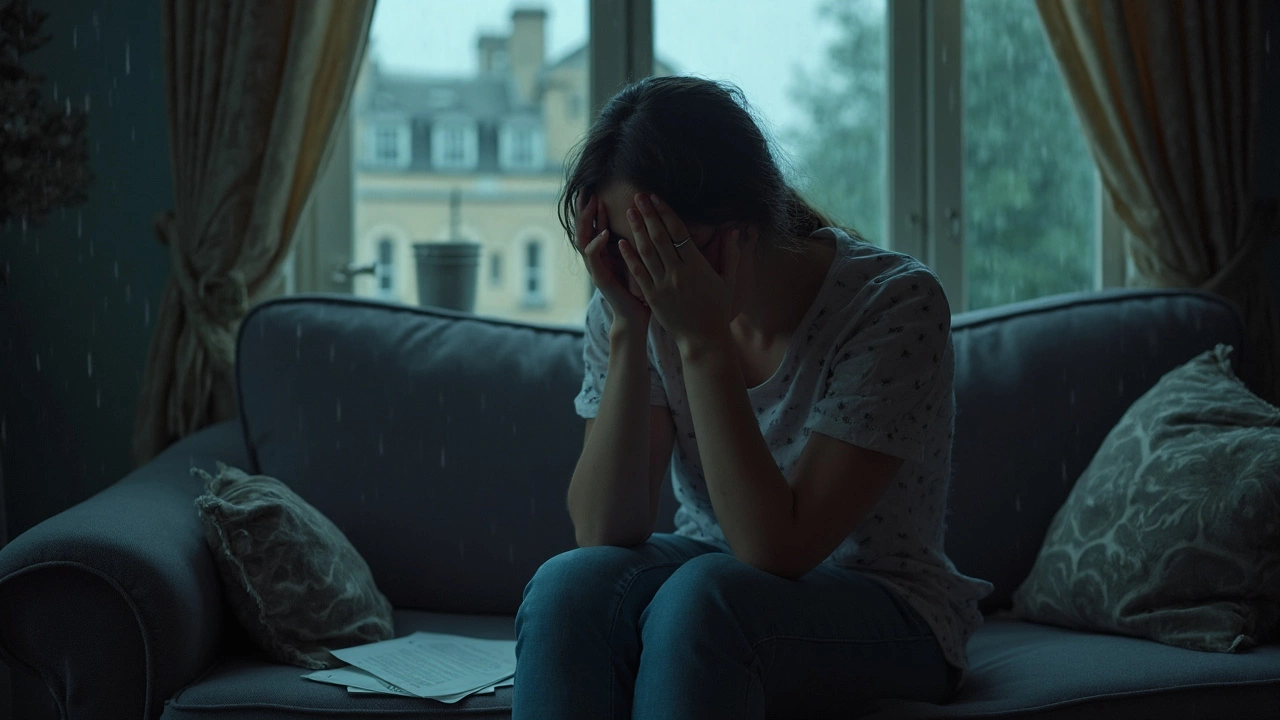Mental illnesses hurt in ways a broken bone just can't compare. Some conditions are described by those living with them as absolute torture, not because of physical symptoms, but because it feels like emotional pain that doesn't let up. Ever wonder which mental illness tops the pain charts? It might surprise you to know it’s not always the ones you hear about most on TV.
People often mention depression or anxiety first, but among therapists and folks who’ve been there, Borderline Personality Disorder (BPD) has a reputation for being one of the most painful. Why is that? It's not just sadness or worry—it’s an overwhelming, second-by-second storm of raw emotion that doesn’t take a break. Some people with BPD say it feels like having third-degree burns on your soul. That’s not just drama, it’s a real description straight from group therapy sessions.
If you or someone you care about is in the middle of this, it can feel hopeless. But even the hardest days can get lighter, bit by bit. There’s help, and there are ways to take back some control, even if it doesn’t feel possible at first. The next sections go into why this kind of mental pain stands out, what it actually looks like day-to-day, and what steps can make a real difference.
- The Reality of Mental Pain
- Why Borderline Personality Disorder Tops the List
- Daily Struggles: A Look Inside
- Finding Relief: Real Strategies That Help
- Support, Stigma, and Hope for Change
The Reality of Mental Pain
It’s easy to spot a physical injury—blood, bruises, even a cast—but mental pain is invisible and often way more confusing. People living with a painful mental illness aren’t just "sad" or "in a mood." They’re dealing with nonstop emotional pain that hijacks their thinking, energy, even their body. Science backs this up. Brain scans show the areas involved in emotional pain light up in almost the same way as when you feel real, physical pain. That’s why rejection or trauma can hit as hard as a broken leg.
Mental pain messes with sleep, appetite, memory, and even immune response. Chronic stress or depression can raise your risk for diabetes, heart disease, and serious infections. Here’s what studies have found about how mental pain connects with the body:
| Issue | Impact |
|---|---|
| Chronic Depression | Up to 54% more likely to develop heart disease |
| Severe Anxiety | Linked to higher blood pressure and digestive issues |
| Unresolved Trauma | Greater risk of autoimmune disorders |
When pain drags on, it isn’t just hard to get out of bed. People feel isolated, misunderstood, or even ashamed. In group therapy, some say the worst part isn’t just the feelings themselves—it’s feeling alone in those feelings, and like nobody "gets it." That just adds another layer of hurt.
If you haven’t felt mental pain yourself, here are a few things people say: "It’s like drowning and everyone else is breathing air." Or, "I can’t relax, ever. My mind is on fire." These aren’t exaggerations—they’re daily reality for a lot of people. So, when someone talks about struggling, brushing it off as "just in their head" really misses the whole picture. This stuff is real and deserves the same care as any physical illness.
Why Borderline Personality Disorder Tops the List
If you’ve ever heard someone talk about living with Borderline Personality Disorder, or BPD, they might mention it’s like being on an endless emotional rollercoaster. There’s a reason BPD gets called the most painful mental illness so often. It’s not about being dramatic—it’s how the symptoms pile up and hijack everyday life.
The kind of pain people with BPD feel isn’t just one thing. It’s a mash-up of intense emotions, exploding relationships, fear of being abandoned, major trust issues, and a deep sense of emptiness. Imagine feeling hurt by a small comment for hours, or swinging between loving someone and hating them in the same afternoon. That’s a normal Monday for someone with BPD.
Here are the main reasons BPD stands out:
- Emotional sensitivity: People with BPD react fast and hard to things most others might shrug off. It’s not just a bad mood—the highs and lows are intense.
- Fear of abandonment: Even a friend being late can spark panic. It’s not about being clingy, it’s about terror that you’ll be left alone forever.
- Self-harm and suicidal thoughts: This is tough to talk about, but around 70% of people with BPD try to hurt themselves at some point. That’s way higher than other mental health conditions.
- Unstable relationships: People with BPD can switch from feeling super connected to friends or partners to suddenly feeling angry or betrayed, even if nothing much has changed.
- Chronic emptiness and identity crisis: Many describe feeling empty inside, like they don’t really know who they are or what makes them tick.
Take a look at these numbers showing just how tough BPD can be. This isn’t meant to scare you, but to show why it needs serious attention:
| Fact About BPD | Reported Data |
|---|---|
| Rate of suicide among people with BPD | About 1 in 10 |
| Self-harm occurrence | Up to 70% |
| BPD diagnosis (percent of population) | About 1.4% |
| Women diagnosed vs. men | 75% diagnosed are women |
One more thing: BPD pain goes deeper because it often comes with other issues like depression, anxiety, or PTSD. That means people aren’t just fighting one battle—they’re juggling several. That’s a tall order for anyone, and makes living with BPD seriously tough.
If any of this sounds familiar, you’re not alone. Lots of people deal with BPD but don’t talk about it because the stigma is still huge. Understanding why this disorder hurt so much is the first step to cutting through shame and making things better.

Daily Struggles: A Look Inside
Living with borderline personality disorder (BPD) isn’t just about having strong feelings. It’s waking up every day feeling like you’re stuck on a rollercoaster that never slows down. One day you might be on top of the world, the next you feel like nobody would notice if you disappeared. That swing is exhausting. It’s not just a metaphor—people with BPD really do report experiencing pain that’s as harsh as physical suffering.
Relationships are one of the hardest parts. Imagine constantly worrying that even your closest friends or partner are about to abandon you at any second. It’s not simply being sensitive. Everything feels dialed up—like background noise blasting in your ears. Arguments can turn into panic. Compliments might feel fake, and any criticism cuts way too deep. So, it’s common to pull people in close and then push them away, just to avoid getting hurt first.
This isn’t just talk. Real research from the National Institute of Mental Health shows that up to 80% of people with BPD will try to harm themselves at some point, not always because they want to die, but to get a break from the emotional pain. Here’s what that looks like in numbers:
| Percentage | Experience |
|---|---|
| 80% | Self-harm or suicide attempt |
| 90% | Report unstable relationships |
| 60% | Struggle with intense mood swings daily |
If that wasn’t enough, daily stuff like going to work, school, or even grocery shopping can feel almost impossible. One small comment from a coworker can wreck your morning. Lots of folks with BPD have trouble with impulsive decisions—like spending way too much money in a mood swing, or upending their life after a rough day.
It’s not about being “dramatic” or weak, and it isn’t something you can just snap out of. Dr. Marsha Linehan, who developed Dialectical Behavior Therapy (the gold standard for BPD treatment) says,
“People with BPD are like people with third-degree burns over 90% of their bodies. Lacking emotional skin, they feel agony at the slightest touch or movement.”
The truth is, borderline personality disorder is exhausting. The pain is real and constant. For many, navigating each day is a victory. That’s why the right kind of help—and people who get it—matter so much.
- Unstable emotions can change by the hour, not just the day.
- Small setbacks or even boredom may trigger overwhelming feelings.
- There are long stretches where it feels impossible to trust yourself or others.
- Getting help is tough, but not out of reach—therapy really can make a difference.
If you or someone close to you is stuck in this cycle, don’t brush it off. This is one of the most painful mental illness experiences, and facing it head-on is nothing short of brave.
Finding Relief: Real Strategies That Help
The pain from borderline personality disorder can feel endless, but real tools do exist to make life bearable and even enjoyable. There’s not one magic cure, but people with BPD and other painful mental illnesses have found a mix of therapies, habits, and mindset shifts that actually work. Here’s what helps the most, based on research and what real people say makes a difference.
Dialectical Behavior Therapy (DBT) is often called the gold standard for BPD. DBT teaches practical things—how to calm yourself before things explode, handle anger or rejection, and build skills for relationships. In a 2022 medical review, up to 77% of people stuck with DBT and most reported feeling less overwhelmed by emotions within six months.
- DBT Skills: Learn specific strategies like ‘opposite action,’ radical acceptance, and distress tolerance. These aren’t just therapy buzzwords—they’re steps you practice over and over until they stick.
- Structured routine: Keeping a regular schedule for sleep, meals, and activities helps stabilize mood swings. It sounds simple, but studies show people with BPD do better with reliable routines.
- Medication: While there’s no pill for BPD itself, meds can help with anxiety, depression, or anger that comes along for the ride. Psychiatrists will tailor this to the person, not just the diagnosis.
- Support networks: Finding people who “get it” (whether that’s a friend, group, or online community) makes a huge difference. Group therapy, peer support, or even a Reddit group dedicated to BPD can cut the isolation.
- Emergency plans: Having a go-to plan for major emotional crashes—like contacting a specific person or using a safety box with comforting reminders—can save lives. Many people with BPD set this up with their therapist.
Let’s get specific about what actually helps, with a quick look at key studies and numbers:
| Strategy | Who Benefits Most | Reported Improvement Rate |
|---|---|---|
| Dialectical Behavior Therapy (DBT) | People with BPD, high emotional swings | Up to 80% feel better within 12 months* |
| Medication for symptoms | BPD with anxiety, depression, anger | About 60% report some relief |
| Peer or support groups | Both diagnosed individuals and loved ones | 50% feel less alone and more hopeful |
*Numbers from a 2023 meta-analysis published in the Journal of Personality Disorders
There are also smart day-to-day habits that chip away at the intensity. Things like using crisis text lines, writing down feelings before reacting, or practicing ten minutes of mindful breathing can seriously help. Most importantly, don’t give up just because the first try didn’t work—mental pain may feel impossible, but the right mix of strategies can open up a real shot at relief.

Support, Stigma, and Hope for Change
If you've ever felt judged for struggling with a mental illness, you're not alone. Stigma is one of the biggest roadblocks to getting help for painful mental illness like BPD. Many folks keep things secret out of fear of backlash at work, at home, or even in the doctor’s office. In fact, almost 60% of people living with borderline personality disorder say they’ve faced discrimination when asking for help. It just adds another layer of pain to the mix.
Good support makes a world of difference. Studies show people with real, non-judgmental support from friends, family, or even a therapist have better chances of feeling better and staying out of crisis. Don’t know where to begin? Here are a few tips to build a support network that actually works:
- Find someone trustworthy and let them in on how you really feel. You don’t need to spill everything at once—start small.
- Therapists trained in dialectical behavior therapy (DBT) know how to support BPD specifically. DBT isn’t just talk, it’s tools for real life.
- Online support groups or apps for BPD and other mental health struggles can give you a safe place to vent or share wins.
It’s not all doom and gloom. Attitudes are changing thanks to mental health campaigns and more people talking openly about their tough days. Some workplaces now offer mental health days, and schools are adding classes about emotions and stress. It’s nothing like perfect yet, but it’s miles better than just a decade ago.
Check out the numbers in this quick table:
| Fact | Percentage |
|---|---|
| People with BPD facing stigma in healthcare | 60% |
| Higher suicide risk compared to general population | 50x |
| Peer support proven helpful in recovery | 70% |
The most practical thing you can do? Don’t let fear of people’s opinions stop you from reaching out. The right support isn’t just nice, it can be life-saving. And if you’re supporting someone you care about, never underestimate how much showing up and listening helps. As more people step up, stigma shrinks—and hope gets bigger.





